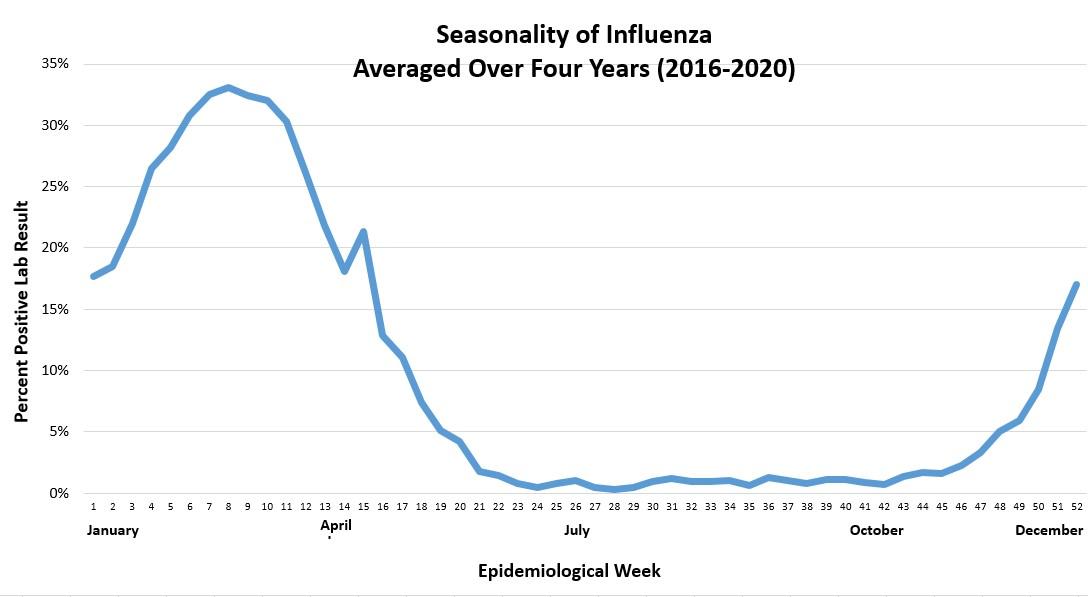About Influenza (Flu)
The flu is caused by influenza viruses that spread easily from person-to-person. The virus infects the nose, throat, and lungs.
Anyone can get the flu. People who have pre-existing medical conditions, those who live in long-term care facilities, and children younger than 5 are at greater risk for more severe illness from the flu. However, it is important to remember that even young and healthy people can also become very sick.
The flu can be spread at any time, so it is important to take precautions year-round. For information on how to protect yourself against the flu, visit our Flu Prevention page. For more information on avian flu, visit our Avian Influenza A Virus page.
The flu is spread directly from infected people or from objects that infected people have touched
- The flu virus is found in droplets from the nose and throat of infected people.
- When infected people cough or sneeze, those droplets can be breathed in by people around them or land on objects around them.
- If someone touches an object with the virus on it, and then uses their hands to touch their face, mouth, or eyes, the virus can make them sick.
Symptoms can show up one to four days after being exposed to the flu virus
The flu can cause mild to severe illness and can sometimes lead to death. Symptoms usually begin suddenly, unlike the common cold. Many people who get the flu will recover in a few days to two weeks, but some people may become very sick, or have complications that may be life-threatening. Complications can range from sinus and ear infections, to pneumonia and multi-organ failure. Many people who become very sick are older than 65 have a medical condition such as diabetes or asthma, kidney disease, or are pregnant.
Common signs and symptoms
- Fever
- Chills
- Headache
- Tiredness
- Dry cough
- Sore throat
- Runny or stuffy nose
- Body aches
Note: Not everyone will have a fever with the flu.
When to seek medical advice
It is important to know when to seek medical advice if you have the flu. There are warning signs and symptoms to watch out for in adults and children, such as trouble breathing, a fever that won't go away, or a fever that returns after you start to feel better. These signs may mean that you have complications related to the flu, such as pneumonia, and need to get treatment immediately. The symptoms of flu are also very similar to those of COVID-19.
Emergency warning signs and symptoms in adults
- Difficulty breathing or shortness of breath
- Pain or pressure in the chest or abdomen
- Sudden dizziness
- Confusion
- Severe vomiting
- Flu-like symptoms that improve but then return with a fever and worse cough
- Kidney failure
- Liver disease
Emergency warning signs and symptoms in children and infants
- Fast breathing or trouble breathing
- Bluish skin color
- Not drinking enough fluids
- Not waking up or not interacting
- Irritability
- Flu-like symptoms that improve but then return with a fever and worse cough
- High fever with a rash
- Being unable to eat
- No tears when crying
- Significantly fewer wet diapers than normal
Most people get influenza in the fall and winter.
Department of Health Services (DHS) resources
- Weekly Respiratory Virus Surveillance Report, P-02346: Weekly report that includes trends of respiratory viruses and influenza vaccination information.
- Flu Fact Sheet, P-42064 (multiple languages): Educational fact sheet for the general public on the flu covering signs and symptoms, diagnosis, and prevention
- Is it the flu, a cold, or whooping cough?, P-02263 (PDF): Flyer outlining the differences between the flu, a cold, and whooping cough
- Wash Your Hands!, P-01710 (multiple languages): Flyer with instructions on how to properly wash hands
- Handwashing Fact Sheet, P-42052 (multiple languages): Educational fact sheet for the general public about correct handwashing technique and how to prevent the spread of disease
- Who Can You Protect? Flyers encouraging flu vaccine for specific populations:
- Family, P-01984 (multiple languages)
- Infant, P-01984A (multiple languages)
- Pregnant Women, P-01984C (multiple languages)
- Seniors, P-01984B (multiple languages)
- Respiratory Viruses, P-03082 (multiple languages): Educational fact sheet outlining the differences between influenza, parainfluenza, adenovirus, respiratory syncytial virus (RSV), human metapneumovirus, rhinovirus, enterovirus, and coronavirus
- Respiratory Illness Vaccine Promotion Toolkits: Toolkits for health care providers (Word), local and Tribal health departments (Word), people who are pregnant (Word), and K-12 schools and early care and education programs (Word) regarding the importance and promotion of respiratory illness vaccination.
CDC (Centers for Disease Control and Prevention) resources
- Seasonal influenza webpage (Seasonal flu webpage in Spanish): CDC webpages that contains comprehensive influenza information
- Influenza communication resources
The flu is preventable. Visit our Flu Prevention page to learn how to protect yourself from the flu.
Questions about the flu? Contact us!
Phone: 608-267-9003 | Fax: 608-261-4976



